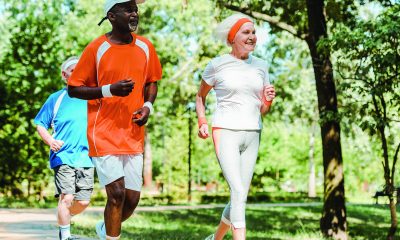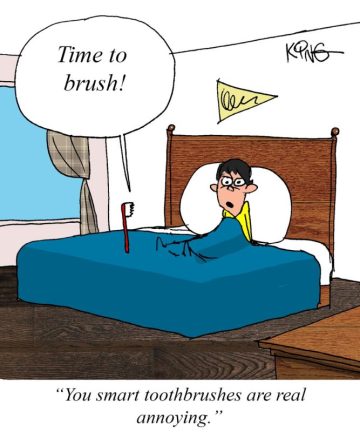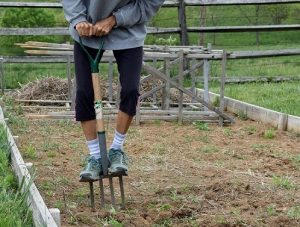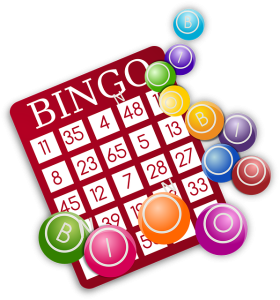Health
Keep fit and enjoy life!

It’s not because you’re retired that your days have to stretch into a succession of endless hours. It’s just the opposite! Now is the time to enjoy life. Here are some tips to help you stay in shape for years to come.
• Watch your diet. It’s important to eat well to prevent obesity and its harmful effects on your health. The revised American Food Guide is a good reference tool that contains recommendations for the different age groups.
• Exercise. Walk, dance, swim, bike, play golf, or do Tai chi. In other words, stay active. And don’t just exercise your body; your brain also needs a workout. Keep your mind sharp by doing crossword puzzles or playing memory games.
• Relax. You’ve lived a full life; now take the time to relax. Reduce stress through meditation or yoga, or relax with a good book.
• Have fun. To be in good shape is also a matter of well-being, because to stay fit you have to stay happy. That is why it’s important to keep busy. Retirement is the perfect time to indulge in the passions you’ve always neglected or to explore and discover new ones. Seize every opportunity to laugh and have fun with your loved ones.
Follow the recommendations of your doctor; take your medications, stop smoking, relax, and enjoy Mother Nature and all that wonderful fresh air. In other words, take care of yourself and make the most of life!
Explore all your options; you may discover some new passions.
Health
Spotlight on Oral Health: The Top 8 Adult Dental Concerns
Oral health is vital to our overall well-being, but it’s often overlooked until problems arise. Understanding and recognizing the signs of common dental issues can help you take action before they escalate. Here’s a rundown of eight frequent oral health problems that adults face and why staying vigilant is key to maintaining a healthy smile.
1. Cavities
Cavities are areas of tooth decay caused by the acidic by-products of plaque bacteria eroding the enamel. If left untreated, they can lead to severe toothache and infections.
2. Stained Teeth
Various factors can lead to tooth discoloration, including tobacco use and the consumption of certain foods and drinks (like coffee, wine, and dark-colored vegetables). Some medications also contribute to this problem, affecting the brightness of your smile.
3. Tooth Sensitivity
Exposed tooth roots due to gum recession or gum disease can lead to sensitivity. This means hot, cold, sweet, or acidic foods and drinks can cause discomfort or pain.
4. Gingivitis
The early stage of gum disease, gingivitis, is characterized by inflammation of the gums. Symptoms include redness, swelling, and bleeding during brushing or flossing. It’s primarily caused by plaque build-up.
5. Damaged Tooth
Teeth can be chipped, cracked, or broken due to accidents, falls, or biting down on hard objects. This affects your smile and can lead to further dental issues if not addressed.
6. Mouth Cancer
Oral cancers can manifest as bumps, sores, or rough patches in the mouth. Early detection through regular dental check-ups significantly improves the chances of successful treatment.
7. Periodontal Disease
An advanced form of gum disease, periodontal disease affects the tissues and bones that support teeth. Without treatment, it can lead to tooth loss and has been linked to other health issues.
8. Tooth Movement
Our teeth naturally shift as we age, potentially leading to overcrowding or misalignment. This can complicate oral hygiene and increase the risk of cavities and gum disease.
Act Early, Stay Healthy
Recognizing these common dental issues is the first step toward prevention and treatment. Good oral hygiene practices, including regular brushing, flossing, and dental check-ups, are crucial. If you notice any signs of the above conditions, consulting with your dentist promptly can help keep your smile bright and healthy.
Health
Unlocking the Power of Protein: Satisfy Hunger and Preserve Muscle
In nutrition and dieting, protein is honored for its unparalleled ability to satisfy hunger and support muscle maintenance. This is a significant reason behind the popularity of high-protein, low-carb diets. Beyond merely quelling hunger, protein harbors a unique benefit for those on a weight loss journey: the preservation of muscle mass while shedding fat.
Researchers at the University of Illinois have illuminated the role of leucine, an amino acid found in protein, as a critical element in maintaining muscle integrity during weight loss. Leucine has been spotlighted for its muscle-preserving qualities, especially notable when overall calorie intake is reduced, making it a valuable ally in the construction of a lean, healthy physique.
For individuals aiming to harness the benefits of protein and leucine without the added animal fats found in meat, many low-fat, leucine-rich alternatives exist. These include:
- Firm Tofu: A 1/2 cup serving contains 1,511 mg of leucine.
- Low-fat Cottage Cheese: A 1/2 cup serving offers 1,440 mg of leucine.
- Fat-free Milk: 8 ounces provides 818 mg of leucine.
- Reduced-fat Mozzarella Cheese: 1 ounce comes with 670 mg of leucine.
- Reduced-fat Cheddar Cheese: 1 ounce includes 608 mg of leucine.
- Eggs: One hard-boiled or soft-boiled egg has 538 mg of leucine.
- Cooked Couscous: 1 cup provides 464 mg of leucine.
Incorporating these leucine-rich, low-fat protein sources into your diet can be a strategic move for those aiming to lose weight without sacrificing muscle. This approach not only aids in achieving a more toned and defined physique but also ensures that the body is receiving adequate nourishment to support overall health and well-being.
Adapting your diet to include a variety of these protein sources can offer a balanced and nutritious pathway towards weight loss. Proteins can also more effectively satisfy hunger than fats or carbohydrates and secure muscle mass for a stronger, healthier you.
Health
Gingivitis 101: Recognize, Treat, and Prevent This Common Gum Disease
Gingivitis is a common yet reversible gum disease marked by inflammation of the gums. It’s primarily caused by the buildup of plaque, a sticky film of bacteria that forms on your teeth. Without proper oral hygiene, plaque can harden into tartar, exacerbating gum inflammation and leading to more serious conditions. Understanding the symptoms, treatment options, and prevention strategies is key to maintaining healthy gums.
Recognizing Gingivitis
Gingivitis often manifests as red, swollen gums that bleed easily, especially during brushing or flossing. These signs indicate the presence of inflammation caused by the accumulation of plaque and its transformation into tartar at the gumline. Recognizing these symptoms early is crucial for preventing the progression to periodontitis, a more severe form of gum disease that can lead to tooth loss.
Treating Gingivitis
The good news is that gingivitis is treatable, especially when caught early. Treatment typically involves a professional cleaning by a dentist or dental hygienist to remove tartar buildup. This process, known as scaling, is the only way to eliminate tartar and halt the progression of gum disease. Your dental professional will also provide personalized advice on improving your oral hygiene routine to prevent future occurrences.
For gingivitis related to medical conditions or certain medications, your healthcare provider may recommend adjustments to your treatment plan or lifestyle changes, such as improving your diet or quitting smoking, to mitigate the effects on your gums.
Preventing Gingivitis
Prevention is the best strategy for combating gingivitis. Here are the key steps to keep your gums healthy:
- Brush and Floss Regularly: Brushing your teeth twice a day with fluoride toothpaste and flossing daily are the cornerstones of good oral hygiene. This routine helps remove plaque before it can harden into tartar.
- Regular Dental Visits: Scheduling regular dental checkups and cleanings is essential. These visits allow your dentist to monitor your oral health, remove plaque and tartar buildup, and provide guidance on effective brushing and flossing techniques.
- Manage Medical Conditions: If you have health issues that contribute to gum disease, work closely with your doctor to manage these conditions effectively.
Gingivitis is a warning sign that your oral health needs attention. By recognizing the symptoms early, seeking prompt treatment, and adopting a rigorous preventive care routine, you can reverse the effects of gingivitis and protect your gums from further harm.
Concerned about your gums? Don’t wait. Schedule an appointment with your dentist today to take the first step towards restoring your oral health.
Health
The Hidden Dangers of Ultra-Processed Foods: A Global Health Alert
In a groundbreaking study that has caught the attention of nutritionists and health enthusiasts worldwide, new research highlights the significant risks associated with the consumption of ultra-processed foods. These foods, characterized by their use of artificial flavors, colors, thickeners, and other chemical additives, have been linked to an alarming array of health conditions.
Conducted by researchers at Australia’s Deakin University, the study compiled data from over 10 million participants across 45 meta-analyses. The findings revealed a stark correlation between the consumption of ultra-processed foods and the prevalence of several adverse health conditions. More than 70% of individuals suffering from heart disease, obesity, and diabetes had diets high in ultra-processed foods.
This extensive research sheds light on dietary choices’ profound impact on our health. Ultra-processed foods, often marketed for convenience and long shelf life, are now scrutinized for their potential to undermine health and well-being. The study’s implications extend beyond individual health concerns, pointing to a broader public health issue that demands attention.
The link between ultra-processed foods and a host of health conditions underscores the importance of making informed dietary choices. As the global community grapples with increasing rates of chronic diseases, this research serves as a call to action for individuals, policymakers, and the food industry to promote and facilitate healthier eating habits.
Health
Urgent Health Alert: The Hidden Dangers of Microplastics for Babies and Infants
As Earth Day approaches on April 22, this year’s theme, “Planet vs. Plastics,” casts a spotlight on a pressing environmental and health crisis: the pervasive threat of plastics and microplastics. While the conversation around plastic pollution often focuses on its environmental impact, a crucial and deeply concerning aspect of this crisis is its effect on human health, particularly on our most vulnerable population—babies and infants.
An alarming new report titled “Babies vs. Plastics,” released in conjunction with Earth Day, sheds light on the grave risks that plastics and microplastics pose to young children. The findings underscore the urgent need for further research and action to protect our youngest generations from these invisible threats.
Disturbing Findings from the “Babies vs. Plastics” Report
- Increased Ingestion by Infants: Infants are at a higher risk of microplastic exposure compared to adults. Their natural behaviors, such as crawling, teething, and the tendency to explore the world through their mouths, lead to up to 10 times more ingestion of microplastics and microfibers. Common sources include plastic toys, textiles, and even playground surfaces made from recycled tires.
- Accumulation in Vital Organs: There’s growing scientific evidence that microplastics don’t just pass through the body harmlessly. Instead, they accumulate in critical organs, including the brain, posing unknown long-term health risks.
- Early Exposure: Shockingly, researchers have found microplastics in the human placenta, indicating that exposure begins before birth, during crucial stages of development.
- Links to Health Issues: The presence of microplastics and their associated chemicals in the human body has been connected to severe health outcomes, including increased rates of miscarriage and male infertility.
- Contamination of Essential Nutrients: Microplastics have been detected in dairy products and breast milk, raising alarms about the exposure of infants to these particles through vital sources of nutrition.
- Higher Risk Indoors: The report also highlights that indoor air is more heavily contaminated with microplastics than outdoor air, exacerbating exposure risks for infants who spend the majority of their time indoors.
This Earth Day, the call to action is clear: we must address the plastic pollution crisis to preserve our planet and protect the health of our youngest and most vulnerable. The “Planet vs. Plastics” theme emphasizes the critical need to phase out single-use plastics and tackle the root causes of plastic pollution.
As communities worldwide reflect on how to combat this growing threat, it’s crucial to support initiatives to reduce plastic use and increase research into its health impacts. Our children’s health and our ecosystems’ integrity depend on it. For more information on


The baby boy bites toy block on a bed at home
how to contribute to the fight against plastic pollution, visit earthday.org.
Health
Understanding Local Anesthesia: Your Guide to a Pain-Free Dental Visit
Are you gearing up for a dental appointment and concerned about potential discomfort? Local anesthesia is here to make your experience as pain-free as possible. Let’s break down the essentials of local anesthesia into three easy-to-understand questions so you know exactly what to expect and feel more at ease.
1. What Exactly Is Local Anesthetic?
Local anesthesia is a medication used during dental procedures to numb a specific area of your mouth, ensuring you don’t feel any pain while the dentist works on your teeth. This differs from general anesthesia, which puts you in deep sleep. Local anesthesia allows you to stay awake and alert, minus the discomfort, making it a preferred option for various dental treatments.
2. How Does Local Anesthetic Work?
Local anesthesia can be applied in two forms: topical and injectable.
- Topical Anesthesia: This is usually the first step, where a dentist applies an anesthetic gel to your gums or inner cheek using a cotton swab. It numbs the surface, making the subsequent injection less noticeable.
- Injection Anesthesia: For more profound numbness, a dentist will use a needle to inject an anesthetic directly into the gum tissue surrounding the area being treated. This blocks the nerves from sending pain signals to your brain, effectively numbing the region for the duration of your procedure, which can range from one to several hours.
Both methods aim to ensure a painless experience by targeting the nerves responsible for pain sensation.
3. What About Side Effects?
Local anesthesia is widely regarded as safe, with minimal side effects. After the procedure, you might experience some temporary swelling, bruising where the injection was given, or extended numbness beyond the treated area. These side effects are generally mild and fade within a few hours.
To ensure the best outcomes and minimize risks, it’s crucial to inform your dentist about any medications you’re taking, allergies, existing heart conditions, or if you’re pregnant. This allows them to choose the most appropriate anesthetic and avoid complications.
Local anesthesia is versatile, used for routine cleanings and more involved procedures like wisdom tooth extraction. If dental appointments make you anxious, talk to your dentist about options like conscious sedation, which can help ease your nerves while keeping you awake and responsive.

























































































